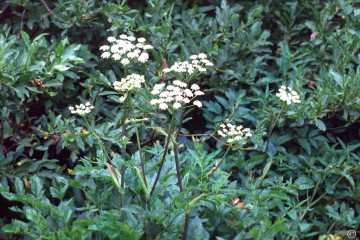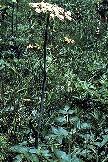

Lyall's Angelica
Angelica arguta Nutt.
Collected during Lewis and Clark expedition near Lost Trail Pass on 3 Sep 1805 and along the Lolo Trail near Hungry Creek in Idaho Co., Idaho, on 25 Jun 1806. No plant material extant, only a bug-chewed label present. (Source)
The stems are stout fluted, 4 to 6 feet high and hollow. The foliage is bold and pleasing, the leaves are on long stout, hollow footstalks, often 3 feet in length, reddish purple at the much dilated, clasping bases; the blades, of a bright green color, are much cut into, being composed of numerous small leaflets, divided into three principal groups, each of which is again subdivided into three lesser groups. The edges of the leaflets are finely toothed or serrated. The flowers, small and numerous, yellowish or greenish in color, are grouped into large, globular umbels. They blossom in July and are succeeded by pale yellow, oblong fruits, 1/6 to a 1/4 inch in length when ripe, with membraneous edges, flattened on one side and convex on the other, which bears three prominent ribs. Both the odour and taste of the fruits are pleasantly aromatic. It grows in moist areas, typically itís found along mountain streams and nearby wetlands.. It has sharp toothed compound pinnate leaves.
Planting: Best planted by the sowing of ripe, fresh seed, though division of old roots is
sometimes recommended, and also propagation by offshoots, which are thrown out
by a two-year old plant when cut down in June for the sake of the stems, and
which transplanted to 2 feet or more apart, will provide a quick method of
propagation, considered inferior, however, to that of raising by seed. Since the
germinating capacity of the seeds rapidly deteriorates, they should be sown as
soon as ripe in August or early September. In
the autumn, the seeds may be sown where the plants are to remain, or preferably
in a nursery bed, which as a rule will not need protection during the winter. A
very slight covering of earth is best. Young seedlings, but not the old plants,
are amenable to transplantation. The seedlings should be transplanted when still
small, for their first summer's growth, to a distance of about 18 inches apart.
In the autumn they can be removed to permanent quarters, the plants being then
set 3 feet apart. Cultivate in ordinary deep, moist
loam, in a shady position, as The plant thrives best in a damp soil and loves to
grow near running water. Although the natural habitat is in damp soil and in
open quarters, yet it can withstand adverse environment wonderfully well, and
even endure severe winter frost without harm. Seedlings will even successfully
develop and flower under trees, whose shelter creates an area of summer dryness
in the surface soil, but, of course, though such conditions may be allowable
when Angelica is grown merely as an ornamental plant, it must be given the best
treatment as regards suitable soil and situation when grown for its use
commercially.
If the plants are well grown, the leaves may be cut for use the summer
after transplanting. Ordinarily, it is the third or fourth year that the plant
develops its tall flowering stem, of which the gathering for culinary or
confectionery use prolongs the lifetime of the plant for many seasons. Unless it
is desired to collect seed, the tops should be cut at or before flowering time.
After producing seed, the plants generally die, but by cutting down the tops
when the flower-heads first appear and thus preventing the formation of seed,
the plants may continue for several years longer, by cutting down the stems
right at their base, the plants practically become perennial, by the development
of side shoots around the stool head.
Food Uses:
It is a popular flavoring for confectionery
and liqueurs. The appreciation of its unique flavour was established in ancient
times when saccharin matter was extremely rare. The use of the sweetmeat may
probably have originated from the belief that the plant possessed the power of
averting or expelling pestiles. The flavor of Angelica suggests that of Juniper berries, and it is largely used
in combination with Juniper berries, or in partial substitution for them by gin
distillers. The stem is largely used in the preparation of preserved fruits and
'configures' generally, and is also used as an aromatic garnish by
confectioners. The seeds especially, which are aromatic and bitterish in taste,
are employed also in alcoholic distillates, especially in the preparation of
Vermouth and similar preparations, as well as in other liqueurs, notably
Chartreuse. From ancient times, Angelica has been one of the chief flavouring
ingredients of beverages and liqueurs.
Medicinal Uses:
The root stalks,
leaves and fruit possess carminative, stimulant, diaphoretic, stomachic, tonic
and expectorant properties, which are strongest in the fruit, though the whole
plant has the same virtues. Angelica is a good remedy for colds, coughs, pleurisy, wind, colic,
rheumatism and diseases of the urinary organs, though it should not be given to
patients who have a tendency towards diabetes, as it causes an increase of sugar
in the urine. It is generally used as a stimulating expectorant, combined with other
expectorants the action of which is facilitated, and to a large extent diffused,
through the whole of the pulmonary region. It is a useful agent for feverish conditions, acting as a diaphoretic.
An infusion may be made by pouring a pint of boiling water on an ounce of the
bruised root, and two table spoonsful of this should be given three or four times
a day, or the powdered root administered in doses of 1O to 30 grains. The
infusion will relieve flatulence, and is also of use as a stimulating bronchial
tonic. It is used for indigestion,
general debility and chronic bronchitis. For external use, the fresh leaves of
the plant are crushed and applied as poultices in lung and chest diseases.
Angelica stems are also grateful to a feeble stomach, and will relieve
flatulence promptly when chewed. An infusion of Angelica leaves is a very
healthful, strengthening tonic and aromatic stimulant, the beneficial effect of
which is felt after a few days' use. The yellow juice yielded by the stem and root becomes, when dry, a valuable
medicine in chronic rheumatism and gout. Taken in medicinal form, Angelica is said to cause a disgust for spirituous
liquors. It is a good vehicle for nauseous medicines and forms one of the ingredients
in compound spirit of Aniseed.

James Reveal's Plants